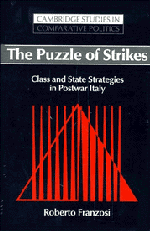Book contents
- Frontmatter
- Contents
- List of tables, figures, and equations
- Dedication
- Preface
- Acknowledgments
- 1 The puzzle box
- 2 Labor-market conditions and bargaining power
- 3 When do workers strike? How the economy matters
- 4 Organizational resources and collective action
- 5 The structure of collective bargaining
- 6 Class power, politics, and conflict
- 7 Mobilization processes: the 1969 autunno caldo
- 8 Countermobilization processes: reactions by the state and employers to strike waves
- 9 The picture in the puzzle
- Epilogue
- Appendix: the data
- Notes
- Bibliography
- Index
7 - Mobilization processes: the 1969 autunno caldo
Published online by Cambridge University Press: 08 January 2010
- Frontmatter
- Contents
- List of tables, figures, and equations
- Dedication
- Preface
- Acknowledgments
- 1 The puzzle box
- 2 Labor-market conditions and bargaining power
- 3 When do workers strike? How the economy matters
- 4 Organizational resources and collective action
- 5 The structure of collective bargaining
- 6 Class power, politics, and conflict
- 7 Mobilization processes: the 1969 autunno caldo
- 8 Countermobilization processes: reactions by the state and employers to strike waves
- 9 The picture in the puzzle
- Epilogue
- Appendix: the data
- Notes
- Bibliography
- Index
Summary
The massive strike waves … march as exclamation marks in labor history …
Shorter and Tilly (1974, p. 104)The characteristic thing about [strike-wave] explosions is that they mark qualitative as well as quantitative changes.
Hobsbawm (1964, p. 127)CLEARLY AN OUTLIER: 1969
The year 1969 is clearly an outlier. The plots reported in Chapter 1 of strike indicators (Figures 1.3, 1.4, and 1.5) and strike shapes (Figure 1.6) singled out that data point as an anomaly. The analyses of the regression residuals throughout this book have provided additional support. What caused the surge in strike activity in 1969? We have seen that the timing of the two major outbursts of industrial conflict in postwar Italy (1959–63, 1969–72) coincided with the timing of both the signing of industrywide collective agreements (1959, 1962, 1963, 1969, 1972) and favorable labor-market conditions (the nearly full levels of employment of the late 1950s and 1960s) (Halevi, 1972, p. 81; see also Bordogna and Provasi, 1979). In terms of my stated goal of fitting together all the pieces of the puzzle, following the clues provided by the available theories, this explanation could suffice. I could call off my investigative work.
But the theory of statistical outliers teaches us that there may be important lessons to be learned from them (Franzosi, 1994). In cross-sectional analyses, we typically throw out outliers, physically removing them from the sample. Because that is more difficult to do with time-series data, we are more likely to take a different route: ignore outliers, or deal with them via dummy variables.
- Type
- Chapter
- Information
- The Puzzle of StrikesClass and State Strategies in Postwar Italy, pp. 257 - 300Publisher: Cambridge University PressPrint publication year: 1995

